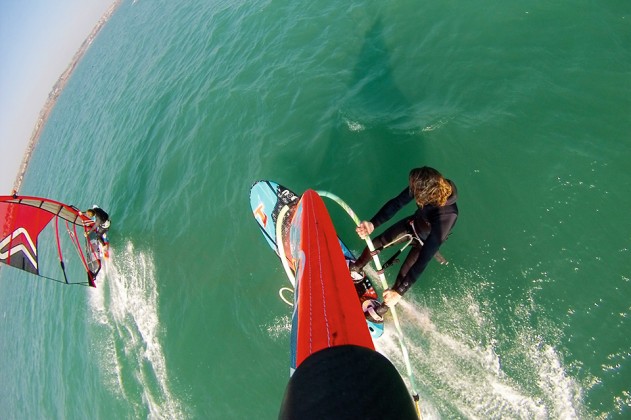A NEW PATH OF DEVELOPMENT
7.8M 3-CAM SLALOM SAIL TEST 2016
Test Editor Tris Best // Second Testers Maurin Rottenwalbter & Tom Wells
Photos Tris Best // Test Location OTC, Portland, Dorset
Cammed freerace sails are largely perceived as de-tuned full slalom machines; just one step away from the no-compromise cutting-edge supercharged engines of the adrenaline-fuelled slalom racer. They are the wise choice for those who want to push their boundaries in speed and slalom racing without committing to a life of constant tuning and hard physical labour on the water. Easier to rig, lighter in the hands … and on the purse, they have become well established for offering more than enough performance for all but the pros on the national and international circuits.
This test was originally published in the May 2016 issue.
FINDINGS
The problem with that analogy is that it sounds too much like a compromise. And for the competitive mind, the word ‘compromise’ is always followed with a nagging thought of, “What if?” What if I did plump for the full on race sail? Would my slalom results for the year be better … or would my speed down the strip be that illusive knot faster? For most recreational sailors, they won’t have a second thought, and they’ll enjoy their 3-cam freerace sail for what it is. But for those aiming to be competitive on their local or national scene, anything less than ‘an all-singing-and-dancing’ engine may give a rival the upper hand. Compromise is always going to be a difficult word to swallow, and historically this is exactly what these sails represented. All the development in sail craft, from seam shaping to material usage, from aspect ratios to mast compatibility, it was all experimented with at the extreme ends of the discipline spectrum. So the 3-cam was effectively a comedown from the slalom programme – a reduction of the cam and carbon batten count, or a reduction of the luff sleeve size to make the sail more forgiving. Sure, the net result is probably more user-friendly overall, but what if the gain in handling didn’t compensate for the loss in ultimate performance? It’s a hard pill to push down the gullet.
So what if “times are a changing” and these sails are developed down a different path to the no-compromise slalom scene? The design brief for the category remains the same but the route to achieve the goals has changed, be it through use of new materials or introduction of a new design concept. We are seeing the green shoots of innovation come through in several brands, making a clear distinction between the 3-cams and their steroid-pumped siblings. First of all, weight reduction seems to be key, and beyond reducing batten and cam count, several brands are switching to fewer seams and lighter materials to keep weight to a minimum. Next, a reduction in boom length makes handling lighter and more manageable, whilst also reducing the amount of distortion possible in the boom when used in extreme winds. It keeps the form of the sail more consistent and power more balanced. However, the biggest development occurring in this sail category has got to be the manner in which the structural stability of the sail is achieved. Convention dictates it is achieved through manipulation of the mast. More luff curve in the sail means more tension is applied during downhaul, loading the mast and locking the draft of the sail in place. On the plus, you have a super secure and dependable sail with unwavering top end stability. The negative is a firm, rigid sail that has little life to it in marginal winds and is physically quite demanding to use for long periods. So into the arena steps a new option, of which several brands here are developing their own paths. Through use of a heavy-duty zero-stretch material in the sail’s chord, the sail itself becomes the provider of stability and structure, requiring less mast manipulation to exact the same stability. What is more, the mast is then at liberty to do what they do best – flex and bend to provide life and elasticity as wind hits the sail, making it feel light, smoother and more responsive. There are of course trade offs as with everything, and in truth I believe we have witnessed the brand’s literally scratching the surface of possibilities in this new design direction. But it is refreshing to have clear water between the design paths of the two sail categories … and as consumers we only stand to benefit more.
SUMMARY
Of the five sails here, the GA Sails and RRD remain advocates of the traditional ‘high luff curve’ approach for establishing stability. Both do it well, the Phantom with exceptional range and ease for a 2-cam and the Firewing sitting best as a 4-cam. The Severne and North Sails are the two innovators of the group, the OverDrive R7 being big and bold with its developments, putting them on full display, whilst the S_Type SL is much more subtle but similarly effective in its own right. That leaves the Loftsails, whose dimensions predictably make it a real powerhouse of a sail, providing bags of positive useable feedback for marginal wind exploitation. But it’s the transformation that occurs when a small amount of additional downhaul tension is applied that really took us by surprise.
TEST LOCATION
This test was conducted at the Official Test Centre (OTC), on Portland, Dorset. The centre is based within the grounds of the National Sailing Academy that hosted the Olympic sailing classes in 2012. With the best wind stats on the south coast, mirror flat water in prevailing winds and a safe launch area with excellent facilities, it provides the ideal test venue. Much of the kit is still on site, so why not go and try some of it for yourself?
uk.otc-windsurf.com
THE LINE UP



